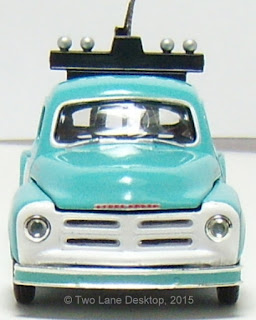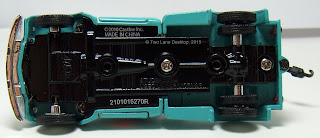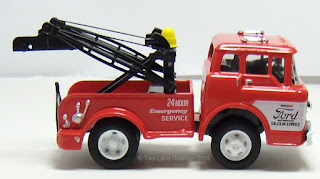M2 Auto Trucks Release 32
It's been a while since the Auto Trucks line was a complete six set and not two or three cars, or has the complete set have mostly new castings either! This latest release brings back the six trucks with four new castings and two veterans returning, one of them also making it's first appearance in the low-end Drivers line as well. Variety is wide in this group with three pickup trucks, two COE's, and one van that does not have the VW logo on it! Let's check out this fantastic group of trucks.
Click Here for Photo Gallery
1949 Studebaker R2 and 1954 R3 Tow Truck
For pickups Studebaker is not a name often heard, but they are out there. M2 decided to create their first pickup casting on the 1949 R2 and 1954 R3 models. The front has the round headlights with signal lights integrated below, with eggcrate grille on the R2 and the Dodge-like gate in the R3. Both versions have the round hood with Studebaker badges but only the R2 has the hood ornament. R2 models get the nifty bed that has a semi-fleetside and semi-stepside look with rear fenders nicely integrated into the bed and giving the R2 a stylish look. The downside is that the bed is not really deep to haul stuff. The rear has dual taillights with the left one occupying the license plate, Studebaker on the tailgate, and a trailer hitch on the rear bumper that so far does not have any small trailers to carry in the M2 line. The bumpers have a color-matching stripe in the center, while the interior opens to reveal the car-like dashboard layout with the gauges integrated into the central chrome strip that also houses the radio speaker, but the gauges are a bit small to read in this tiny slit.
Click Here for Photo Gallery
Open the hood to show the 4.0L I-6 that produces 103 hp. through a 3-speed manual column-shifter. The engine details are nice and show off the silver valve cover and red air filter. The chassis is plain but features the frame, drivetrain components (rear axle is adjustable for larger rear tires), and has the front and rear leaf springs on live axles. The tan looks great in this release, giving it a more high-end look, and goes well with the red steel wheels on whitewall tires. However, the quality control issues (and there's a lot in this Auto-Trucks release) leave the whitewall on the tires to roll kind of odd. The Driver's release in that gorgeous metallic blue was my first R2 and it looks great as a modern hot rod with custom 5-spoke wheels that include wider ones at the rear. The downside of the Drivers line is the hood and doors are sealed up so there is no opening features, and that interestingly enough leaves a better body panel fit than with the opening doors and hood. The 1954 3R is mostly done in dual rear wheels fashion for stake bed, flat bed, or tow truck duty. This blue with Studebaker door logos is one of the best releases of this casting by far, and it looks very good with the color-matching wheels. The rear tow truck body features fenders to cover the dual rear wheels, quad taillights with a trailer hitch, hazard lights on the top of the hitch arms, and a whip tail trailer hitch that, sadly, does not add function by towing any car from its bumper. It is more for show and less for hauling.
Click Here for Photo Gallery
1958 Chevrolet Apache 2WD
One of my favorite castings is the Chevy and GMC 1958-1959 trucks that have so far come in many variations that it eclipses the Studebaker for the amount of variations made (and I think any other M2 castings to date as well). This latest one is nothing new, yet it has a few new features: The roof on the blue one is body-colored, it's a two-wheel drive truck with new steel wheels with small hubcaps in chrome, and the red version for the Driver's line features a new body that makes the hood and doors part of the body (meaning no opening features). The blue one looks great with white bumpers front and rear, grille, and headlight surrounds, silver CHEVROLET on the tailgate, dual taillights, and spear logo's on the front fenders. The bed is not as large as the Ford but at least is deeper than the Studebaker. The interior features the bench seat in gray with the well laid-out dashboard, 3-spoke steering wheel, and 4-speed manual shifter on the floor. Now you may think that this looks like a base work truck model, so the engine is an inline-six, but instead the blue truck has the 283 CID small-block V8. Even with a metal base and skinny tires this truck is a strong performer in the acceleration and handling department The red version looks quite familiar to the GMC versions from a few years ago, but the difference is that this is a 2WD model that shares the same wheels and white bumpers with the blue truck, and it has no opening doors or hood. The top is white and the spare tire is on the left-rear bed area, though the top shows off some rough lines and the rear bumpers on most of these Drivers trucks tends to sag at the left-rear corner of the bumper. Otherwise it has the same interior, body lines, and base details as the blue truck. Despite some flaws and some crookedness both of these trucks look great together.
Click Here for Photo Gallery
1969 Ford F250 Pickup
We're no stranger to this generation of F-series pickups having reviewed the Hot Wheels Texas Drive 'em 4x4 and the Motormax 1:24 short-bed F100, but the M2 version goes for the 3/4 ton F250 version with the long bed. As much as Ford F-series are popular the generations from the 1960 and 1970's have been less frequently seen on the road. Recently i'm starting to see more of the 1967-1972 body styles show up just like the amount of them seen in diecast. The casting starts with a two-tone green and tan setup with a nifty toolbox in the right-side of the bed that carries-over from the previous-generation. Unfortunately my example has a nice scrape on the driver's door that shows the green on the tan surface, and note the fit of the door panel's two-tone does not evenly align with the rest of the body version. Silver trim and logo's spruce up the side trim, and those 5-spoke chrome hubcaps over steel wheels return yet look perfectly fine here. The rear has slot taillights, FORD on the tailgate, and adorning silver trim. The bed is nice and large thanks to the long bed design even if the bed is not deep enough. The front has the egg-crate grille with round headlights, signal lights below, and nifty vertical bumper pads, and a blacked-out grille that one must question was this really offered on the 1969 F250 or is this just a lack of chrome?
Click Here for Photo Gallery
The hood doesn't want to close shut leaving a noticeable gap, but when you open it you see the blue-painted 360 CID V8 that produces 215 hp. through a three-speed automatic. The radiator stands nice and tall and that air filter cover is big and wide; pretty impressive here. The doors open to an interior that for the first time features lap belts on the ribbed front bench seat. The dashboard has nice silver touches for the gauges and central controls, and the three-spoke steering wheel is nice and deep. The base leaves more to be desired as the engine bay details were sorely neglected. The rear axle piece shows hope of a dually or wide-tire rear in the future. So far it's decent but I need to see more variations to see how well this casting fits in the line, and if M2 has more bed styles to offer as well.
Click Here for Photo Gallery
1965 Ford Econoline TravelWagon
For a while M2 never ventured into vans, but that all changed thanks to the introduction of the VW line and the Microbus. Now Ford has joined the fray with the first Econoline van, with the first release in a panel van with either cool flames or as a Shelby support vehicle. Now comes the passenger van done into a camper called TravelWagon. The turquoise is amazing and really makes this casting pop out, as does the tan interior, silver wheels with chrome hubcaps that feature two rotating FORD letters, and the silver camper top with side windows and the front AC unit. The first Econoline, as with the Dodge A100 and Chevy Greenbrier Wagon, were designed to go after the success of the VW Microbus. However, every manufacturer had their own way of doing it as the Chevy went for the same rear-engine air-cooled flat engine to the Dodge and Ford to the front-mounted I-6, and later V8, motors. The Econoline success then moved itself to the next-generation where the hood started to grow in the next two generations. The front has the distinctive headlights in the side grille vents, FORD logos inbetween, and lower grille with white bumper. The rear has round taillights, panel doors, FORD letters in the center, and the license plate holder on the left door. The sides show a sweeping lower beltline that starts with the cut-out of the front doors, only interrupted with the passenger-side panel doors.
Click Here for Photo Gallery
The interior features two front seats that sit next to the engine cover, large footwell room, bus-like steering wheel, and silver accents on the gauges. In the back there is lots of detail with the table and facing seats that can covert to a bed, a mini fridge, a sink, and cabinets that are highlighted with silver accents. With the dome roof adding headroom, plenty of windows around the cabin, and in-house A/C this is one comfortable travel companion. The base shows off the leaf springs on live axles and the 240 CID I-6 and three-speed column-shifted manual transmission. Because of the fear that the extra weight at the front would offset the back Ford added a metal plate just above the rear axle to balance the weight transfer. While lacking opening features this Econoline looks cool in camper trim, and one must wonder if a Mercury version or a Pickup is not too far behind in M2's future plans.
Click Here for Photo Gallery
1970 Ford COE Tow Truck
After 1957 the Ford C-series COE started a new life as the long-standing COE with the cab now over the engine and front wheels. It's hard to believe that this model has lasted until 1990 when the Ford Cargo took over the job! This Ford COE is a rather large cab that is square and has more room than the Dodge COE thanks to the extended cab profile. The front has round headlights with a lower grille and bumper, FORD in the center joins the 24 hr. Service Ford Emergency service in red and white deco. The sides lack the exposed steps (they're now inside when you open the door), the windshield is still split (though some models have a one-piece design as M2 obviously prepared for this possible variation), and the dual horns join the clearance lights on the roof, though the horns tend to rotate around during shipping requiring some repositioning before display. As with the other COE's the tow truck body carries over unchanged, adorning the red paint and 24 hr. service logo's on the sides. However, the tow truck body does not like the new COE as a banana effect occurs between the two of them (i've been told it's due to the two tabs not lining up with each other between the cab and bed). Inside the interior has a bare metal cab with the dashboard being part of the front cab with only the gauges the sole separate part. There is only room for two people even with plenty of space in the rear cab. The frame is the same as other COE's, but the new mounting holes to secure the truck to the base are much closer and in effect cut off the driveshaft. The COE comes with a variety of gas and diesel motors, with this M2 version likely using the 361 CID V8 and 5-7 speed manual transmission. In my opinion the new Ford COE looks rather odd with its large square cab, but then again it's served three decades so it should be fitting to the M2 COE line.
Click Here for Photo Gallery
1966 Dodge L700 COE
The final model in this release is one that will bring back memories of those who built the model kit of this model: the L700 COE. Based on the new forward look of the Dodge line that includes the A-series vans and pickups the L700 uses a cab-forward look with round headlights, 4-slot grille, and lower bumper that oddly has two hooks for some reason. The roof has dual horns and clearance lights, while the sides have integrated fender steps and signal lights next to the headlights. Note how this cab really, and I mean really is front and ahead of the front wheels; so bad that with this fifth wheel hitch version there's so much weight that if you tip the truck forward it will stay in that position! The wheels are a new 6-spoke design in white and the fuel tanks are smaller and more square. The interior features seating for three and a car-like dashboard layout with flush-mounted gauges and radio controls for a clean, simple look. Powertrains mostly come from the truck engine line that includes a 5.2L V8 that makes 210 hp. through a 4 or 5-speed manual transmission. One of the goals of these new modern COE's was the access to the engine: The ones from the 1950's have access from the hood but with the engine so deep down in the body it was hard to do routine maintenance to the engine. The true COE's resolved that by fixing the cab over the front wheels, thus allowing the cab to tip forward for easy access to the engine area. I think this is a more stylish approach to the COE than the Ford C-series.
Click Here for Photo Gallery
While i'm not sure what's next from M2, or if i'll have a six truck set with four new castings again in varying degree of diversity, these classic trucks bring the cool back to American trucks that has been long lost to modern trucks that are more about functionality than style.
Update 1/2/2018: The Ford Econoline has gotten much use lately and at the end of 2017 a special Wal-mart set that includes six uniquely-designed Econoline's. The Ambulance version is the most popular, followed by this Mercury Econoline wagon. As mentioned before the Mercury brand sold Ford Trucks in Canada as a way to avoid a dispute that was finally ended in 1970, and in the process Ford Trucks sold in the U.S. were badged as Mercury's in Canada. This fine-looking wagon in light blue and white looks great and the only change was the front and rear badging to Mercury. On the other hand M2 finally got around to changing the wagon interior from using the camper tooling to a new one that has two forward-facing rear bench seats in a two-tone color. Very nicely done and still looks good even as a Mercury!
The Studebaker pickup was part of the M2 Wild Cards series last year and it looks good blacked-out with blacked-out steel wheels on whitewall tires, blacked-out trim that was once chrome, and a tan interior. This one also has the canvas topper over the bed with Studebaker across the sides:


















































































































Comments
Post a Comment